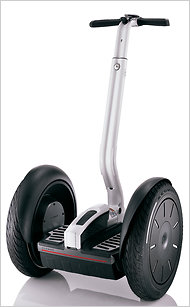Humans have been inventing since the beginning of the civilization, whether out of necessity for survival or simply to improve their lives. New products and services will always be cropping up but success begins with one crucial step: talking to the target audience.
Countless ideas fail or never materialize after showing a lot of promise because market researchers either neglect or misunderstand the results from this step. Segway and PlayPump are just two examples of ideas that sounded good on paper but that eventually flopped.
Segway Tries to Revolutionize
The Segway, two-wheel personal transportation, was set to transform the automobile industry when it first launched in 2001. The head of Segway, Dean Kamen, said that it “will be to the car what the car was to the horse and buggy.”
But it proved be a spectacular failure when only 30,000 units sold between 2001 and 2007. The price point was the big reason as to why the company failed to gain any traction in the urban planning industry. Consumers were just not ready to pay anywhere from $3,000 to $7,000 for what was essentially a glorified scooter.
Segway has remained in business though, in part because they shifted their focus from a mass consumer base to a niche market. Segway PTs are often seen being used by security officers or tourists doing “Segway tours” in big cities.
PlayPump Makes No Traction
PlayPump had a more noble purpose than Segway, which was to bring drinking water to African communities. It was a simple yet powerful idea, to replace traditional hand pumps by harnessing children’s energy to produce clean drinking water. A merry-go-round type of device would be installed and connected to a water pump, and as children played on it, water would be pumped into a storage tank.
Millions of dollars went into funding the project. It even received endorsements from Laura Bush and AOL founder Steve Case. In practice, PlayPump was fraught with problems. The merry-go-round was too heavy for older women to spin and the pumps broke down very quickly. With no maintenance plan in place, the pumps were ruined in record time.
PlayPump was only useful in places that already had clean water, rendering it obsolete in places that didn’t have access to clean drinking water. There was also the question of whether it was appropriate to rely on children to constantly have to play in order to have water. The device was was creating more problems than it was solving.
What seemed to be a game-changer when it started, turned out to be another failure in market research. It’s telling that in one of the PlayPump sites in Mozambique, women were quoted as saying that the old hand pumps were easier and that no one had consulted them about the change – the PlayPump just came.
Products and services generally exist to solve problems. Even the best ideas can’t survive without people who use them for one reason or another. Carefully researching what the target audience wants will go a long way in ensuring that a great idea does not turn into yet, another failure.
By Diana Zelikman, Written by the editors at Fueled. We develop iPhone and Android apps.
Image Credits: wheels.blogs.nytimes.com, asmarterplanet.com


